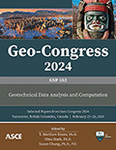Numerical Analysis of Two-Dimensional Tank Experiment of Microbially Induced Desaturation (MID) in Layered Silts and Sands
Publication: Geo-Congress 2024
ABSTRACT
A numerical reactive transport model was developed to simulate microbially induced desaturation (MID), an emerging bio-mediated ground improvement technique. MID employs nitrate-reducing microorganisms to produce gas bubbles that desaturate granular soils, thereby enhancing the cyclic shear strength of the soil. MID is of particular interest due to its potential to mitigate earthquake-induced soil liquefaction non-disruptively, for example, underneath existing structures. The model couples fluid flow with reactive transport and predicts the distribution of substrates and products and changes in porosity, permeability, and degree of saturation from MID. The numerical model was implemented in COMSOL Multiphysics finite element software and validated using bench-scale tank experiment results. Comparison of changes in the degree of saturation and electrical conductivity, time-lapse images, and the breakthrough curves observed during the experiment with the results of the numerical simulations provides insight into the distribution of biomass and consequent varying reaction rates throughout the tank.
Get full access to this article
View all available purchase options and get full access to this chapter.
REFERENCES
FHWA. (2011). “LRFD Seismic Analysis and Design of Transportation Geotechnical Features and Structural Foundations.”, 592 p.
Hall, C. A., van Turnhout, A., van Paassen, L., Kavazanjian, E., and Rittmann, B. (2023). “Multi-phase Biogeochemical Model for Microbially Induced Desaturation and Precipitation.” EGUsphere, 1–22.
Hamdan, N., Kavazanjian, E., Rittmann, B. E., and Karatas, I. (2017). “Carbonate Mineral Precipitation for Soil Improvement Through Microbial Denitrification.” Geomicrobiology Journal, 34(2), 139–146. https://doi.org/10.1080/01490451.2016.1154117.
Jain, A. K., and Juanes, R. (2009). “Preferential mode of gas invasion in sediments: Grain‐scale mechanistic model of coupled multiphase fluid flow and sediment mechanics.” Journal of Geophysical Research: Solid Earth, 114(B8).
Kavazanjian, E., O’Donnell, S. T., and Hamdan, N. (2015, November). “Biogeotechnical mitigation of earthquake-induced soil liquefaction by denitrification: a two-stage process.” In Proceedings of 6th International Conference on Earthquake Geotechnical Engineering, Christchurch, New Zealand (pp. 20–28).
Kwon, P., Karmacharya, D., and van Paassen, L. A. (2023). “Reactive Transport Model to Evaluate Process Performance of Bio-Mediated Liquefaction Mitigation underneath Existing Structures.” In Geo-Congress 2023 (pp. 80–88).
NASEM. (2016). State of the Art and Practice in the Assessment of Earthquake-Induced Soil Liquefaction. National Research Council Committee on State of the Art and Practice for Assessment of Earthquake-Induced Soil Liquefaction, National Academies Press, 350 p. https://doi.org/10.17226/23474.
O’Donnell, S. T., Rittmann, B. E., and Kavazanjian, E. (2017). “MIDP: Liquefaction Mitigation via Microbial Denitrification as a Two-Stage Process. I: Desaturation.” Journal of Geotechnical and Geoenvironmental Engineering, 143(12), 04017094. https://doi.org/10.1061/(asce)gt.1943-5606.0001818.
O’Donnell, S. T., Hall, C. A., Kavazanjian, E., Jr., and Rittmann, B. E. (2019). “Biogeochemical model for soil improvement by denitrification.” Journal of Geotechnical and Geoenvironmental Engineering, 145(11), 04019091.
Okamura, M., and Soga, Y. (2006). “Effects of pore fluid compressibility on liquefaction resistance of partially saturated sand.” Soils and Foundations, 46(5), 695–700. https://doi.org/10.3208/sandf.46.695.
Pham, V. P., Nakano, A., van der Star, W. R. L., Heimovaara, T. J., and van Paassen, L. A. (2017). “Applying MICP by denitrification in soils: A process analysis.” Environmental Geotechnics, 5(2), 79–93. https://doi.org/10.1680/jenge.15.00078.
Pham, V. P., van Paassen, L. A., van der Star, W. R. L., and Heimovaara, T. J. (2018). “Evaluating Strategies to Improve Process Efficiency of Denitrification-Based MICP.” Journal of Geotechnical and Geoenvironmental Engineering, 144(8), 04018049. https://doi.org/10.1061/(asce)gt.1943-5606.0001909.
Rebata-Landa, V., and Santamarina, J. C. (2012). “Mechanical effects of biogenic nitrogen gas bubbles in soils.” Journal of Geotechnical and Geoenvironmental Engineering, 138(2), 128–137.
Rittmann, B. E., and McCarthy, P. L. (2001). Environmental Biotechnology: Principles and Applications, McGraw-Hill Education, New York. https://www.accessengineeringlibrary.com/content/book/9781260440591.
Stallings Young, E. G., Zapata, C. E., and Van Paassen, L. (2020). “Unsaturated fluid flow through granular soils treated with microbial induced desaturation and precipitation.” E3S Web of Conferences, 195. https://doi.org/10.1051/e3sconf/202019505003.
van Paassen, L. A., Daza, C. M., Staal, M., Sorokin, D. Y., van der Zon, W., and van Loosdrecht, M. C. M. (2010). “Potential soil reinforcement by biological denitrification.” Ecological Engineering, 36(2), 168–175. https://doi.org/10.1016/j.ecoleng.2009.03.026.
van Paassen, L. A., Pham, V., Mahabadi, N., Hall, C., Stallings, E., and Kavazanjian, E. (2017). “Desaturation via Biogenic Gas Formation as a Ground Improvement Technique”. Proceeding of PanAm-UNSAT 2017: Second Pan-American Conference on Unsaturated Soils, ASCE Geotechnical Special Publication 300, pp. 244–256, https://doi.org/10.1061/9780784481677.013.
Wang, L., van Paassen, L., Pham, V., Mahabadi, N., He, J., and Gao, Y. (2023). “A (Simplified) Biogeochemical Numerical Model to Predict Saturation, Porosity and Permeability During Microbially Induced Desaturation and Precipitation.” Water Resources Research, 59(1). https://doi.org/10.1029/2022WR032907.
Yegian, M. K., Eseller-Bayat, E., Alshawabkeh, A., and Ali, S. (2007). “Induced-Partial Saturation for Liquefaction Mitigation: Experimental Investigation.” Journal of Geotechnical and Geoenvironmental Engineering, 133(4), 372–380. https://doi.org/10.1061/(asce)1090-0241(2007)133:4(372).
Zeng, C., Van Paassen, L. A., Zheng, J. J., Stallings Young, E. G., Hall, C. A., Veenis, Y., van der Star, W. R. L., Konstantinou, M., and Kavazanjian, E., Jr. (2022). “Soil stabilization with microbially induced desaturation and precipitation (MIDP) by denitrification: a field study.” Acta Geotechnica, 17(12), 5359–5374.
Information & Authors
Information
Published In
History
Published online: Feb 22, 2024
ASCE Technical Topics:
Authors
Metrics & Citations
Metrics
Citations
Download citation
If you have the appropriate software installed, you can download article citation data to the citation manager of your choice. Simply select your manager software from the list below and click Download.
